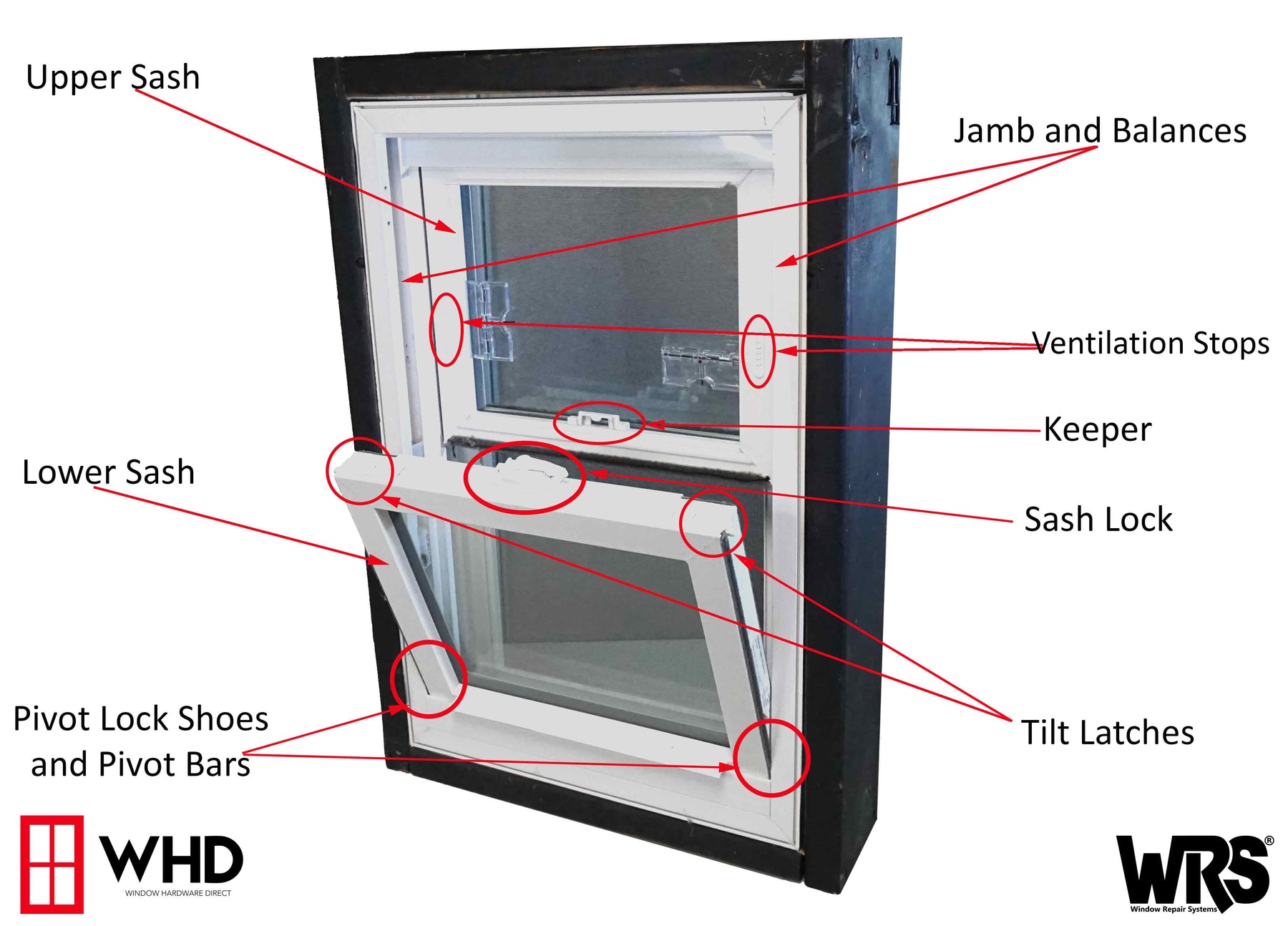
Parts of a Tilting Double or Single Hung Window
Today we're going to be taking a look at the various parts of a tilting double or single hung window. Whether you're looking for replacement parts for your tilting window, or are just curious how tilting windows function, this post will cover all you need to know.

Various parts of a double or single hung window
Sash
We'll start off with the window sash. A window's sash is simply the part of the window that holds the glass and keeps it in place. Generally, the sash can be moved up or down, but some are fixed. For single hung windows, the bottom sash is the only sash that is moveable, for double-hung, the upper and lower sashes can be moved. Window sashes are important to the construction of the window. If a sash is not constructed or installed properly, it may distort and warp over time leading to improperly sealed windows that may leak or stop locking properly reducing the efficiency and security of your home.
Balances
The window balance is a somewhat hidden component. Located on the side of the window, between the sash and the frame, the window balance helps with lifting the sash by counterbalancing the weight of the sash. There are several different types of balances including block and tackle window balances, spiral window balances, clock spring balances, constant force/tape balances, and coil spring balances. All of these types of balances do essentially the same thing, just in a different way. If your window balances are damaged or broken, your window may be difficult to open, not open at all, or may not stay open. If you're looking to replace your balances, we have guides on installing block and tackle balances and installing spiral window balances. Many times, tilt window balances are located inside the window jamb and jambliner.

Location of the window balance inside the window jamb
Jamb
Window jambs are the main vertical parts that make up the sides of a window. Jambs provide structural support for the window and are located inside the actual window frame. Many times, jambs are fitted with a jambliner. The jambliner adds an additional seal to the window. Jambliners come in many variations, shapes, and sizes. Contact us for more information regarding jambliners
Pivot Lock Shoes
Pivot lock shoes are a component found only in tilting windows. The pivot lock shoe fits into the jamb channel and the spiral balances attach to it. The cam for the pivot lock shoe rotates and locks into place when the window is tilted. There are many different sizes and profiles of pivot lock shoes. Contact one of our experts if you need help choosing the appropriate pivot lock shoe.

Location of the pivot lock shoe in the jamb with the spiral balances attached
Pivot Bar
The window pivot bar is the part that allows the window to tilt. The pivot bar fits into the lower part of the sash and one end fits inside the pivot lock shoe's cam. Just like with the pivot lock shoes, there are many different styles and profiles, so if you don't know what you need, contact one of our experts.

Location of Pivot Bar in the bottom of the window sash
Tilt Latches
Window tilt latches are designed to keep your tilt window in the upright position. Most tilt latches are made from plastic, however, the material can vary. Generally speaking, there are three types of tilt latches: internal tilt latches, slide in tilt latches, and surface mounted tilt latches. Internal tilt latches, as the name suggests, are located inside of the window sash and have a small slider or button that is used to activate it. Slide-in tilt latches slide into a channel on top of the sash and surface mounted tilt latches are mounted directly onto the sash. When replacing internal and slide in tilt latches, an exact match is usually required. Alternatively, since surface-mounted tilt latches mount directly to the sash, they can be used to replace internal and slide in tilt latches. Tilt latches are located on both the upper and lower sash of double-hung windows.

Location of window tilt latches on the lower sash
Ventilation Stops
Ventilation stops or locks, or simply vent stops, are used to stop the sash from being opened all the way and are commonly found on double-hung vinyl windows. Vent stops make the window far more secure. If your window does not have vent stops, you can attach a window BanditBar that sticks to the glass and functions in a similar fashion.

Window Vent Stop with BanditBar attached to the glass
Window Sash Lock and Keeper
Window sash locks and keepers are located on the top rail of the sash. The lock is located on the moveable sash and the keeper is located on the opposite side. Locks and keepers are essential to keeping your home secured. The are almost always made of metal and are fairly easy to replace.
These are some of the more commonly found window parts on single and double-hung windows. Each window is different and may contain additional parts. If you are not sure what a part is or don't know which part you need, feel free to contact us or chat with us and one of our experts will be happy to assist you.
